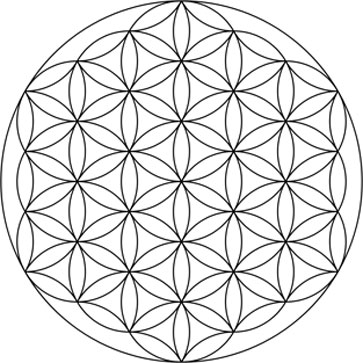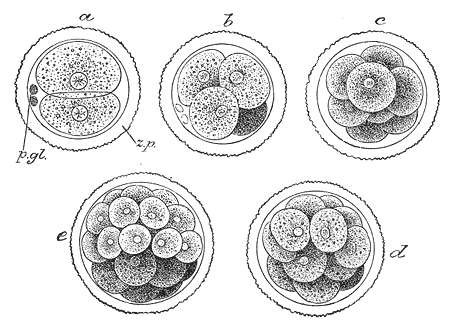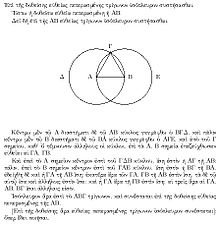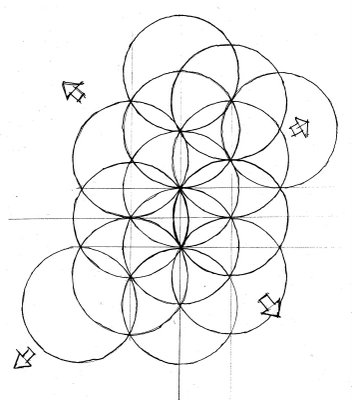The Sacred Geometry of Creation

Patterns of seven overlapping circles appear in historical artefacts from the 8th century BC onwards. They are found on a Cypro-Archaic I cup of the 8th-7th century BC in Cyprus; at the Temple of Osiris at Abydos in Ancient Egypt; and on Roman mosaics, for example at Herod's palace in the 1st century BC. The patterns are used extensively to construct girih decorations including 6- and 12-pointed stars in Islamic art. Patterns based on a square grid of overlapping circles are found in quilt design, in Ancient Egypt as noted in the 1856 book The Grammar of Ornament, and in the Hindu temple at Prambanan in Java.
https://en.wikipedia.org/wiki/Overlapping_circles_grid#Modern_usage
Sacred Geometry is studied as a way of finding insight into creating something from nothing.
Sacred geometry ascribes symbolic and sacred meanings to certain geometric shapes and certain geometric proportions. It is associated with the belief that a god is the geometer of the world. The geometry used in the design and construction of religious structures such as churches, temples, mosques, religious monuments, altars, and tabernacles has sometimes been considered sacred. The concept applies also to sacred spaces such as temenoi, sacred groves, village greens and holy wells, and the creation of religious art.
https://en.wikipedia.org/wiki/Sacred_geometry
The following video explains Sacred geometry a little bit and natures first pattern of sacred geometry.
The vesica piscis is a type of lens, a mathematical shape formed by the intersection of two disks with the same radius, intersecting in such a way that the center of each disk lies on the perimeter of the other. In Latin, "vesica piscis" literally means "bladder of a fish", reflecting the shape's resemblance to the conjoined dual air bladders ("swim bladder") found in most fish. In Italian, the shape's name is mandorla ("almond").
This figure appears in the first proposition of Euclid's Elements, where it forms the first step in constructing an equilateral triangle using a compass and straightedge.
The triangle has as its vertices the two disk centers and one of the two sharp corners of the vesica piscis.
https://en.wikipedia.org/wiki/Vesica_piscis
Patterns in nature are visible regularities of form found in the natural world. These patterns recur in different contexts and can sometimes be modelled mathematically. Natural patterns include symmetries, trees, spirals, meanders, waves, foams, tessellations, cracks and stripes.[1] Early Greek philosophers studied pattern, with Plato, Pythagoras and Empedocles attempting to explain order in nature. The modern understanding of visible patterns developed gradually over time.
In the 19th century, Belgian physicist Joseph Plateau examined soap films, leading him to formulate the concept of a minimal surface. German biologist and artist Ernst Haeckel painted hundreds of marine organisms to emphasise their symmetry. Scottish biologist D'Arcy Thompson pioneered the study of growth patterns in both plants and animals, showing that simple equations could explain spiral growth. In the 20th century, British mathematician Alan Turing predicted mechanisms of morphogenesis which give rise to patterns of spots and stripes. Hungarian biologist Aristid Lindenmayer and French American mathematician Benoît Mandelbrot showed how the mathematics of fractals could create plant growth patterns.
Mathematics, physics and chemistry can explain patterns in nature at different levels. Patterns in living things are explained by the biological processes of natural selection and sexual selection. Studies of pattern formation make use of computer models to simulate a wide range of patterns. https://en.wikipedia.org/wiki/Patterns_in_nature
Natures first pattern
Every embryo when it is in the womb of its mother follows nature's first pattern of sacred geometry to form itself until it is in the flower of life pattern or more complicated.

Feel free to comment and Discus this topic Below, I hoped you enjoy it.


Hi. I am a volunteer bot for @resteembot that upvoted you.
Your post was chosen at random, as part of the advertisment campaign for @resteembot.
@resteembot is meant to help minnows get noticed by re-steeming their posts
To use the bot, one must follow it for at least 3 hours, and then make a transaction where the memo is the url of the post.
If you want to learn more - read the introduction post of @resteembot.
If you want help spread the word - read the advertisment program post.
Steem ON!